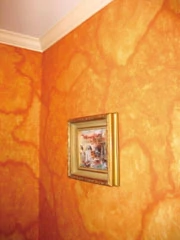Deck the Walls With the popularity of home improvement shows such as Trading Spaces and Changing Rooms, do-it-yourselfers and novices interested in home improvement are becoming more interested and adventurous when it comes to interior design. The wide variety of materials available at home stores makes it that much easier to change the feel and decor of your homes¹ spaces. Perhaps the easiest and most cost-effective way to make a dramatic change in your room is with the walls. Follow these simple instructions to create beautiful, eye-catching wall treatments.
Choose Your Mood Without a doubt, paint is the cheapest way to change the mood and warmth of a room. Rule #1: Do not be afraid of color. Although white walls are the least risky, they are also very difficult to pull off without feeling institutional or unfinished. Look at your surroundings and objects that you love for inspiration. It could be a favorite sweater, a color from a beautiful fabric, or even the spring colors in your yard. Pick up a color wheel and match the paint chips to your inspiration color.
Another great thing about simply painting a room is that anyone can do it. All you need is the few materials listed here, and a few hours. In the project pictured we chose a dark gray /green paint color for a small dining room. As you can see, the paint color creates a warm, rich atmosphere.
Fresco Finish Drywall was the finish of choice for Post-War America, but now the trend is reversing towards the old-world look of fresco. Use this technique to create a rich, luxurious look.
Apply the plaster tex to the walls in generous amounts, working in manageable sections. Use the wallpaper smoother or plastic joint knife to get into corners and to the ceiling and baseboards. Hold the smoother at a parallel angle to the wall, and using light pressure, knock down peaks as you go. Remember, you are not striving for perfection. It¹s the imperfections that make this treatment beautiful. Allow the plaster to dry completely.
Mix AquaWax with a small amount of acrylic paint (color of your choice) to tint and place in a paint tray. Load a foam roller with the tinted wax and remove excess with paper towels. Create a ³random pattern² by rolling the way lightly over the wall. Pour Stain & Seal into a paint tray. Apply to the wall in workable sections with a 3-inch chip brush. To keep the stain wet and workable, mist the wall lightly with water. Use the large stipple brush to work the stain into the surface of the plaster. The ³random pattern² will not accept the color as you apply, allowing the design to show through for a distressed look.
Fabric Fabulous Although fabric wall coverings can be quite expensive depending on the cost per yard, fabric is a great way to add drama and texture to a room. It is also good for covering walls with serious imperfections or damage. Fabric is very versatile as well. You can create padded fabric walls using foam batting and plywood, or flat fabric walls that mimic the look of wallpaper. In this example, learn how to create a pleated fabric wall.
Begin by measuring the wall or walls to be covered from the ceiling to the top of the baseboards or floor for length. Measure the entire width of the wall, and triple it so you have enough fabric to create wide pleats.
Work from one side of the wall to the other and pre-cut all of the panels first. Beginning at the upper-left edge, pleat and staple the fabric along the wall. Be sure to overlap the edges of the fabric and repeat until the entire wall is covered. Cover the raw stapled edges of the fabric along the top and bottom with molding or decorative trim.
A blank wall can be transformed into the canvas of your choice with a little imagination and the right materials. Consider paint, a fresco finish, fabric or even metal or leather for your next project.



